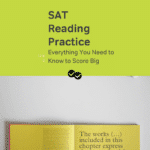SAT reading passages can be a little hard to pick apart. They’re not light reading, and you probably won’t have any real interest in the topic. And they’re full of detail, a lot of which ends up being pretty unnecessary for the questions.
It’s true that there are lots of questions that ask about specific parts of the passage, but you won’t know ahead of time which of those little bits are the juicy ones. You’ll need to search out that info in the reading after seeing the question.
While you read, then, you shouldn’t worry about the little things. Instead, you want to focus on the author’s approach and the passage’s structure.
The main idea of SAT reading passages
Since SAT reading excerpts are pretty short (compared to the texts they’re taken from), they’re usually about one clear topic that’s explored in a limited way and concluded neatly. They’re self-contained.
That means it’s usually pretty easy to find the main topic of the reading in the first few sentences of the passage. The first paragraph, at least, will have a sentence or two which are key to whatever it is the author is trying to get across. Because of that, the introduction to the passage deserves special attention. Find those key thoughts! They may not be thesis sentences exactly, because they might not make an argument, but they’ll be crucial in some way.
Make connections
Read most of the text pretty quickly, without worrying about getting every detail. Focus on finding the main point of each paragraph.
The next part is absolutely critical for nailing SAT reading questions. Every time you have the main idea of a paragraph, ask yourself two questions:
How is this related to the main topic (from the beginning)?
How is this related to the paragraph before it?
There are a number of common connections such as explanation, contrast, cause and effect, listing, and contextualizing.
There will be some connection or another—otherwise they wouldn’t belong to the same passage—so make sure you’ve jotted down at least some kind of purpose for the paragraph or section in your notes. And yes, you should definitely be taking notes.
When reading the conclusion
At the end of the passage, revisit that original question. What was the purpose of all this? Why did they author write this passage at all? Is it something out of a history text book, or are they arguing an opinion? Revise that “thesis” based on the final thoughts, thinking especially about the writer’s tone.
Why SAT reading structure is important
A whole lot of questions on your SAT will ask things that require you to understand the overall point of the passage. Big picture questions aren’t the only ones; inference questions and questions about the author’s intentions also test you on it.
Go into the questions having picked apart the structure of the passage and you’ll be a lot better off.






Leave a Reply